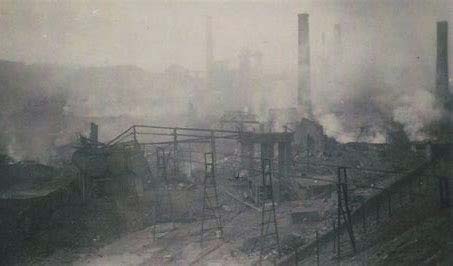Local History Society Report
The Low Moor Munitions Explosion of 1916
Mary and Geoff Twentyman (co-researched with Barbara Reardon)
Tuesday, 20 October 2020
Hebden Bridge Local History Society's series of Webinar lectures continued with a dramatic and engaging exploration of the devastating explosion of the Munitions Factory at Low Moor Bradford in 1916 – an accident waiting to happen. Mary and Geoff Twentyman, with colleague Barbara Reardon, have been researching this area of Bradford for many years, and their talk provided a masterclass in the use of a variety of different historical records and sources.

OS maps of the period show that the factory, located at Low Moor, south of Bradford and close to Shelf, was part of an industrial development with an adjacent Iron Works Dye Works and a Gasometer. On Monday 21st August 1916, that proved crucial to the seriousness of the explosion.
First stop for researchers, the National Archive at Kew, unearthed some fascinating claim forms from local residents for broken crockery, damaged windows and some rebuilding work – but it was a shock to Mary and Barbara that a significant number of documents relating to the accident had actually been destroyed, with just a few samples retained. However other archives and sources filled in much of the picture. The picric acid that was used in the process of making explosives had to be handled very carefully, and it seems that due precautions were not followed when transporting the drums of the dry acid. The official inquiry noted that as it was a sunny day, the drums were not covered with tarpaulins as the regulations required, and the drums were probably dragged on cobbles causing friction and the initial spark. A hissing from the drum was heard, and flames were seen, and then came the explosion.
The archives of the Fire Brigade filled in some more of the dramatic details of a rescue involving several fire brigades, including the Works Fire Brigade and engines from Odsal and Bradford. When the engines arrived they were met by the fleeing workers and hindered by the restricted access of a protected site. A series of explosions blew up the first of the fire engines, killing the chief fire officer. The works manager was also in charge of the Works Fire Brigade and was seen crawling from debris, but died soon after. The fire brigade accounted for 7 of the 40 casualties, many only identifiable by the identity number inscribed on their axes.
One of the most poignant parts of the talk was the work done to identify and put faces to the victims of the disaster. There was no contemporary newspaper accounts, as strict censorship ruled out such negative stories at the height of the war. The women, who made up the majority of the workers, suffered mainly superficial injuries. Other workers were not so lucky; men in the picric acid works, a police officer and railway fireman were among those killed.
Some individual stories emerged: a worker aged just 17 died on his first day at work, having twice tried to join the army and serve at the front, his mother had persuaded him to take what she saw as a safe job.
Photographs of the devastated site bear an uncanny resemblance to images of the Somme, which was still very raw in the memory. Family photos of those who died or who were recognised for their bravery give extra power to the stories, and are a reminder of the importance of such records. Firemen, police and telephone operators were among those awarded gallantry medals.
The work done by Mary, Barbara and Geoff has brought into focus the identities of those who died, who are now commemorated on a board close to the site, on the Spen Valley Greenway walk. A book written by Barbara Reardon and Mary Twentyman records these stories, and its title 'Yellow Poppies' recalls the way the skin of the munitions workers was turned yellow by the picric acid. Another happy result of the research has been the human connections: family members who have been contacted and were able to learn the details of the deaths or heroism of their ancestors often for the first time.
The Hebden Bridge Local History Society AGM will be held via Zoom on 28th October at 7.30. The next lecture on 11th November at 7.30 will be the Alan Petford Memorial Lecture, when Anne Mealia will be talking about the Fieldens and their legacy in Todmorden. All the current programme of lectures until December will be delivered as Zoom webinar meetings and non-members are welcome to sign up for these.
Details of the talks programme, publications and of archive opening times are available on the Local History Society website and you can also follow the Facebook page.
With thanks to Sheila Graham for this report
See also

